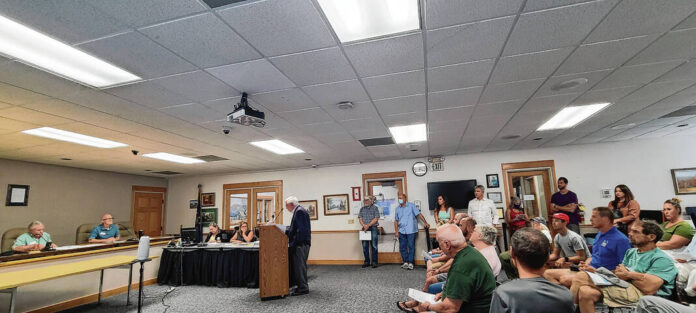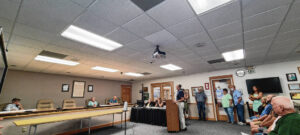
Knobstone Hiking Trail Association legal adviser Tony Abbott addresses the Brown County Commissioners during a meeting on July 20. The meeting room was full with Tecumseh Trail supporters. Abbott asked the commissioners to amend a resolution closing the railroad crossing on Indian Hill Road to state the resolution was intended to prohibit vehicular traffic on that section of road and at the crossing, but not pedestrian traffic hiking the Tecumseh Trail.
For more than 20 years hikers have traveled through Brown County on the Tecumseh Trail, making their way across the Indian Hill Road railroad crossing on their trek down one of the longest hiking trails in the state.
Now hikers take a 5- to 6-mile walking detour around the railroad crossing following its closure two years ago at the request of the Indiana Rail Road.
In the spring of 2020, the railroad company asked the Brown County Commissioners to close the crossing, which is near the State Road 45 end of Indian Hill Road, due to safety concerns related to line of sight and how steep the embankment is leading up to the crossing.
When that happened, it cut off access from Indian Hill Road to the highway.
Since the closing, Tecumseh Trail users have lobbied to open the crossing to pedestrian traffic — and that lobbying has not slowed.
The Salmon Room was full of trail users and supporters at the July 20 commissioners meeting as Knobstone Hiking Trail Association legal adviser Tony Abbott formally requested the commissioners amend the resolution closing the crossing to state it was intended to prohibit vehicular traffic on that section of Indian Hill Road and at the crossing, but not pedestrian traffic.
“We believe there was an unintended consequence of that closure, which resulted in severing the Tecumseh Trail,” Abbott said.
The Tecumseh Trail continues to grow after an extension was recently authorized in Yellowwood State Forest.
In June, the KHTA received authorization from the Indiana Department of Natural Resources Forestry Division to complete the short extension — roughly 0.34 miles in length. When the extension is completed, the Tecumseh Trail will connect to the “D” Trail. Hikers can then follow the D Trail south into Hoosier National Forest where the trail connects with Knobstone Trail, totaling around 160 miles — making it the longest continuous hiking trail in the state.
The Tecumseh Trail and the D Trail, with the additional 5.5 miles of trail from the Hoosier National Forest, creates a forested hiking trail that is 85 miles long, making it the longest forested hiking trail in Indiana from Morgan-Monroe State Forest headquarters to Clear Spring. This extension has been sought for several years. This is the first substantial progress in adding to the system of long distance hiking trails in Brown County since the Tecumseh Trail was completed in 2001.
The Tecumseh and Knobstone are regional assets that bring hikers and backpackers in from all over, supporters said. The Knobstone Trail goes through Morgan, Brown, Monroe, Lawrence, Jackson, Washington, Scott and Clark counties.
During the commissioners meeting, Abbott said that the criteria that was used to close the railroad crossing relates to vehicular traffic only, including the alignment of the road and the railroad, and the angle of the intersection of an alignment at the crossing along with the number of vehicles and posted speed limit for the crossing.
In the railroad’s company letter to the commissioners it states that if the commissioners determine the crossing does not meet the criteria for closure or that it does meet the criteria, but “a compelling reason has been shown to exist” that the crossing remain open they should reach out to Peter Ray, the vice president of engineering for the rail road company, to start the appeal process.
Abbott then said that severing the Tecumseh Trail could have been identified as a compelling reason if the commissioners had held a public hearing before the crossing was closed. Under Indiana Code, a public hearing should be held not more than 60 days after a petition is received to close a railroad crossing. Following a hearing a government unit and the rail road company could then agree to close a crossing if a reason was not identified to keep it open during the hearings.
“The trail has been there and it has served Brown County residents and other trail users statewide for 20 years, but you wouldn’t know that unless you invite the public to have comment and input,” Abbott said.
“We’re not asking the board to vacate its resolution, we’re only asking the board to clarify its resolution and adopt the amendment indicating that it closes the crossing and road to vehicular traffic, but it was never intended to include pedestrian or foot traffic.”
He continued that there are “some potential hazards” when a vehicle uses the crossing, such as the angle of the embankment going up to the track. Despite these hazards, the railroad company reported there had not been any accidents reported at that crossing in the last five years.
“If you were to drive a truck or a car up a steep embankment you may have to get very, very close to that narrow ridge where the tracks are at for you to be able to see if a train is coming or not and if so at what speed,” he said.
“But if you were a person on foot you could approach that embankment and those tracks cautiously, you would be listening, you would be seeing and if there was a risk of injury there you could find out about it, avoid the potholes or the uneven parts in the railroad.”
Offering help
Indiana Rail Road put together a proposal for the county to close the crossing with the commissioners’ approval in 2020.
At that time, it was stated that the railroad company could have bypassed the commissioners if they did not agree to the closing. Previously commissioner President Jerry Pittman said that if the commissioners had not agreed, the railroad company could have gone to the Indiana Department of Transportation, which could remove the entire road from the county’s road inventory, resulting in a funding loss.
Along with supporters in the audience, Abbott also presented the commissioners with six letters of support for the pedestrian crossing including one from Dist. 65 state Rep. Chris May and five other state legislators including Dist. 65 state Rep. Matt Pierce who also attended the July meeting.

Pierce is a member of the General Assembly Trails Caucus, a bipartisan caucus of state senators and representatives who wish to promote trails in the state. He said trails are not only good for recreation and health, but also for economic development as they bring people from all over to a county to hike and compete in different distance events.
After hearing from people all over the state about the closure’s affect on the Tecumseh Trail in Brown County, Pierce said he began looking further into the situation and discovered the commissioners felt they had no choice but to close the crossing. He then reached out to INDOT and the federal Railroad Administration.
Representatives from both agencies told Pierce they have statutory authority to close a crossing on appeal, but that as a matter of policy they have determined they “never want to do that” and that a railroad crossing closure would not impact road inventories. Crossings are inventoried by the federal Railroad Administration.
“What I am hearing from INDOT is I think you have more leeway here than you might have thought when you originally made your decision. If we need to have the legislature help put a meeting together with the right people at INDOT so you can have a face-to-face understanding of exactly what is going on there I would be more than interested in helping with that,” Pierce said.
“We (the legislature) stand ready to help you in any way.”
Two residents also spoke in support of opening the crossing to pedestrian traffic. One resident, Jake Adams, also encouraged the commissioners to consider opening the railroad crossing to both vehicles and pedestrians again. He said the railroad company should work to improve the safety of it so it could be reopened for pedestrians and vehicles.
“There are a lot of residents there who would be in danger if their homes caught fire or anything were to happen. That was a beautiful stretch of road, I know it was kind of dangerous with the grade, but it was there for railroad. They did that to the road essentially,” he said.
After hearing from trail supporters, Pittman said he had no intention of closing the crossing to pedestrian traffic.
“I will admit my ignorance. I didn’t know the trail crossed there and I didn’t factor that into my decision making. I am all for the trail. I would like to see it reopened,” he said.
“I am just not sure in all of this maneuvering between the railroad, INDOT and us how we will get it resolved. I am willing to work with you absolutely to get it reopened.”
The commissioners’ attorney Mike Moga said in July that the railroad crossing property is owned by the railroad company. At the Aug. 3 commissioners meeting, Commissioner Diana Biddle said a deed shows the railroad company owns 150 feet of property on both sides of the track where hikers would cross.
At the meeting last week, Biddle said there were no further updates on the situation as the commissioners’ attorneys, Abbott and the railroad company were all in continued discussion about the crossing.




